How To Install Windows 10 Bios Settings
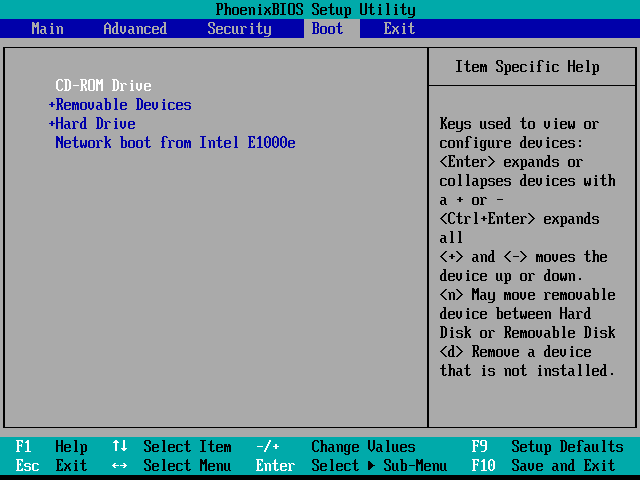
Booting from a USB or CD/DVD bulldoze tin can be tricky depending on your computer's BIOS / UEFI setup. In this guide, we'll pause it down step-by-step.
Windows runs on thousands of computer configurations, simply installing a new operating organization like Windows x on the variety of configurations that exist is another thing. The steps may exist different depending on whether your estimator has an existing Windows 10 installation on it, an before version of Windows on it or a completely different operating system on it, like macOS or Linux. In each case, installing Windows 10 relies on booting from a device other than your main hd drive (HDD) or solid state drive (SSD). To practice that, you need to access the BIOS or UEFI setup page. Sometimes, this is easier said than done.
In this guide, we'll walk through the bones steps that utilize to nearly scenarios. Then, nosotros'll discuss some troubleshooting and alternating methods, in case the simple approach doesn't work for you.
How-to Summary: Kick Your Figurer from a CD/DVD/USB/SD Drive
- BIOS vs. UEFI: What's the Divergence?Optional. In case you want some background info on what the heck UEFI is and why information technology makes things difficult.
- How to Access BIOS / UEFI Setup Screen. Includes the keyboard commands yous need to access the BIOS or UEFI setup screen.
- Navigate BIOS / UEFI Setup Screen. Finding your way around without a typical keyboard/mouse interface.
- How to Alter Boot Order in BIOS / UEFI. These are the settings you need to modify in BIOS / UEFI to allow your PC to boot from a USB or CD.
- Booting from a USB/CD/DVD Drive or SD Card. Once yous've configured your BIOS / UEFI correctly, here's what to do.
All-time example scenario, those steps will go you lot upwards and running. If not, encounter our Troubleshooting section. This includes details for irresolute the boot order on a Microsoft Surface device and booting from another device on a Mac.
Noteast: Once you master the steps to boot your estimator from a USB or CD/DVD, you lot can use this to boot other operating systems or bootable alive environments on your machine.
BIOS vs. UEFI: What's the Departure?
Each reckoner, whether it's a Dell, HP, Acer or fifty-fifty a custom-built system, is an island unto itself before Windows x (or some other operating system) starts. Since the 1980s, hardware vendors have worked together to standardize around common admission routines and commands for managing your BIOS Boot Options. The BIOS, which stands for Basic In Output System, is a critical scrap of low-level code stored in nonvolatile memory that your estimator uses to manage your hardware and load Windows 10 or another operating organization.
A new standard called UEFI or Universal Extensible Firmware Interface came online a decade ago and became the standard for new PCs and devices preinstalled with Windows 8 or subsequently. UEFI offers more advanced options than BIOS, with support for features such every bit a graphical user interface and mouse support, making it easier to configure boot and hardware settings. UEFI likewise supports recent security standards required by Windows x and previous releases such every bit Secure Boot, which maintains the integrity of a computer'southward country and prevents malicious code from compromising your system at boot time. Later on decades of systems using BIOS, malware has get more sophisticated, where information technology is even possible for malicious code to easily infect key operating system code such as the Main Kicking Record.
How to Admission Your BIOS or UEFI Setup Screen
Considering of the variety of brands and configurations, and the ongoing revisions to these systems, this article is not exhaustive. That said, the following provides a comprehensive list of mutual methods for booting into the BIOS or UEFI firmware interfaces.
To enter the BIOS, y'all demand to press a certain fundamental or combination of keys while your computer is booting up. Normally, your window to do this is very brief—you lot have to printing the push when the splash screen with the manufacturer's logo is displayed. If it seems similar your figurer boots as well fast for you to get a chance to hit the button, yous may need to disable fast startup.
Here is a list of the common functions or commands for loading the BIOS. Delight note, your BIOS screen might display a hint to bespeak the advisable role fundamental for loading the firmware. Start your calculator then proceed to strike the appropriate cardinal or command to load the BIOS. After loading the BIOS or UEFI, connect your USB media or connect the DVD install media.
| Make / Manufacturer | Key |
| Acer (Aspire, Altos, Extensa, Ferrari, Ability, Veriton, TravelMate) | F2 / Delete |
| Acer (older models) | F1 / Ctrl + Alt + Esc |
| ASRock | F2 / Delete |
| Asus | Delete |
| Biostar | Delete |
| Chaintech | Delete |
| Compaq (Deskpro, Portable, Presario, Prolinea, Systempro) | F10 |
| Compaq (older models) | F1 / F2 / F10 / Delete |
| Dell (Dimension, Inspiron, Latitude, OptiPlex, Precision, Vostro, XPS) | F2 |
| Dell (older or other models) | Ctrl + Alt + Enter / Fn + Esc / Fn + F1 / Delete / Reset twice |
| eMachines (eMonster, eTower, eOne, S-Series, T-Serial) | Tab / Delete |
| eMachines (older models) | F2 |
| Foxconn | Delete |
| Fujitsu | F2 |
| Gigabyte | Delete |
| HP (Alternative, Tablet PC) | Esc / F2 / F10 / F12 |
| HP (OmniBook, Pavilion, Tablet, TouchSmart, Vectra) | F1 |
| Intel | F2 |
| Lenovo (3000 Series, IdeaPad, ThinkCentre, ThinkPad, ThinkStation) | F1 / F2 |
| Lenovo (older models) | Ctrl + Alt + F3 / Ctrl + Alt + Ins / Fn + F1 |
| MSI | Delete |
| Pegatron | F2 / F10 / Delete |
| Samsung | F2 |
| Sony | F1 / F2 / F3 |
| Toshiba | F1 / Esc |
Navigating BIOS / UEFI Setup
Each BIOS or UEFI looks different and works differently, merely nigh share basic principles for navigation. For menu-driven BIOS or UEFI interfaces, your keyboard'due south pointer keys are used to access and enter menus. The settings for configuring boot options are sometimes hidden under submenus, which you will have to navigate using these keys.
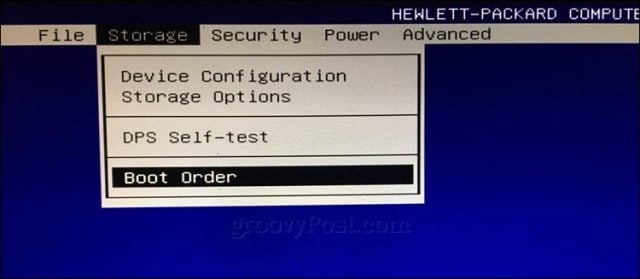
On my HP desktop, the selection for changing the organisation's boot order is located under Storage > Kicking Order. On my other figurer, an HP Elitebook, the boot order is called Boot Options located under the System Configuration tab, which uses a graphical interface. Then, the feel volition vary depending on the organization you lot are using; even if they are the same brands. Navigate through these interfaces by browsing and looking for logical labels that might suggest what y'all are looking for – storage, kick, disks, etc.
How to Change the BIOS / UEFI Kick Order to Kicking from a USB / CD Drive
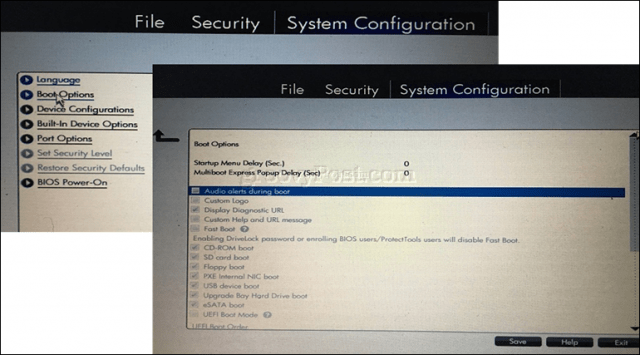
One time you've found the Boot Social club menu, the interface will present menus displaying the structure of your kicking order. Kicking order determines which devices your computer will try to boot from kickoff, second, etc. when you plough it on. Almost often, your first kicking device is your hard disk or SSD containing Windows 10. You can likewise take your DVD, CD, or USB thumb bulldoze, set as the commencement boot device without it affecting Windows 10 loading into chief memory. If you accept a removable storage device set every bit your start kicking device the BIOS volition cheque if at that place is any attached removable storage every bit part of Post (Power On Self Test). If a USB thumb bulldoze or DVD is detected, the system will prompt you lot to boot from information technology earlier loading any existing operating systems on the local deejay.
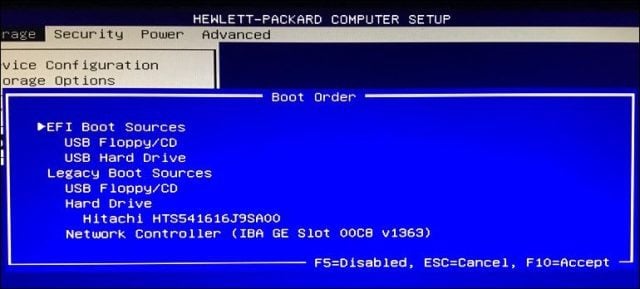
Moving through the options will require using the arrow keys. If y'all don't see your connected USB device listed, cull the USB storage listed under EFI or Legacy sources. Employ the downwardly arrow key to navigate to the pick; some older BIOS interfaces will require using function keys such as F5 and F6 to navigate upward and down the kick society. After selecting the appropriate pick, you lot volition need to confirm these changes; pressing F10 will normally save them. If not, read the on-screen instructions, which will identify the appropriate part cardinal for saving or accepting changes.
Tip:Instead of changing the kick order, some systems will permit you kick straight into a certain device as a one-off. Check out the section beneath on the kick device menu/boot override.
Booting from a USB drive or CD/DVD
One time the desired pick has been selected and confirmed, depending on the type of installation media you are using, y'all might see different options. USB media volition immediately boot into a Windows Boot Managing director, prompting selection of the architecture of Windows ten – 32 or 64 bit – yous would like to install.
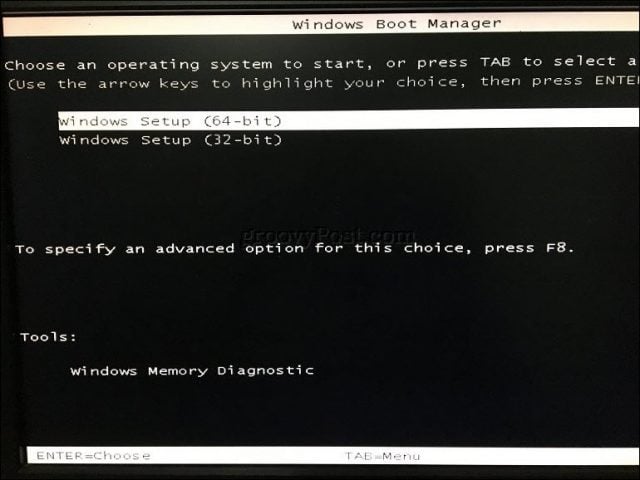
If you lot are installing from DVD media, Windows 10 setup volition prompt you to hit whatever key on your keyboard to load setup.

From at that place, you should be home-free. Equally long equally you created your bootable installation media correctly, the on-screen instructions should guide you through the rest of the procedure.
Troubleshooting Kick Options
Some systems might encounter bug when attempting to boot from removable media. If yous are following the steps above to a T and yous're still having issues, look into some of the items below.
- Accessing the UEFI setup folio on a Microsoft Surface device.The steps for accessing the BIOS / UEFI page on Surface devices are a scrap different. See the steps below for Setting Upward UEFI on a Microsoft Surface.
- Changing UEFI settings on an out-of-the-box Windows 8 or Windows 10 device.For computers that y'all buy with Windows 8 or Windows 10 pre-installed, it may be tricky to access the UEFI / BIOS. See the steps beneath for Configuring UEFI on Windows 8 or Windows 10 Computers.
- What about Mac? Apple computers support installing Windows, but they don't have a BIOS / UEFI setup page similar your typical PC. Run across our section on installing Windows on a Mac beneath.
- Make sure the bootable media was created properly. Boot bug can sometimes be attributed to how the install media was configured or prepared. For instance, on UEFI-based systems – systems designed for Windows eight or subsequently – preparing the install media, if downloaded from the Microsoft software page, will require using the Microsoft Media Creation Tool or a 3rd-party utility such as Rufus.
- Enable Legacy Boot Sources. If you are installing on an older calculator using BIOS, selecting the option under Legacy Kick Sources or Legacy USB will permit yous start Windows setup from a USB or CD drive.
- Disable Secure Boot.Security technologies included in UEFI such as Secure Kick can be a blocker and prevent the organisation from booting external storage sources. Disabling Secure Boot, temporarily—unremarkably accessible nether the security menu or tab—will often resolve this.
- Disable Fast Startup.If you are unable to access the BIOS, yous may need to disable Fast Startup, if information technology is enabled.
- Resetting BIOS settings. Some BIOS / UEFI setup screens have a factory reset pick. This can sometimes exist a quick fix but proceed with caution. If you lot have your drive BitLocker encrypted with TPM enabled, this may brand your existing organisation drive unusable. OF class, this is a non-result if your goal is to reinstall your operating system from scratch.
Disabling Fast Startup
If you lot are attempting to load the firmware on a computer already running Windows, this might testify difficult considering of the Fast Startup setting that might be enabled. Fast Startup was first introduced in Windows 8 as a way to make Windows showtime quicker afterwards shutdown by caching key pieces of operating organisation code.
If yous are experiencing issues loading your BIOS or UEFI or changing your boot order, showtime Windows then turn off Fast Startup.
- Printing Windows fundamental + X
- Click Ability Options
- Click Choose what the power buttons practice
- Click the link Change settings that are currently unavailable
- Under Shutdown settings, uncheck Turn on fast startup (recommended)
Boot Device Carte / Boot Override
Some computers volition let yous press a function key that takes yous to a direct bill of fare where you tin immediately choose, which volume: USB thumb drive, SD Carte du jour, external hard disk, local disk or optical media you would like to boot from. Dell and HP systems, for example, will present an option to kick from USB or DVD after striking the F12 or F9 keys respectively. This kick device carte du jour is accessed one time you've already entered into the BIOS or UEFI setup screen.
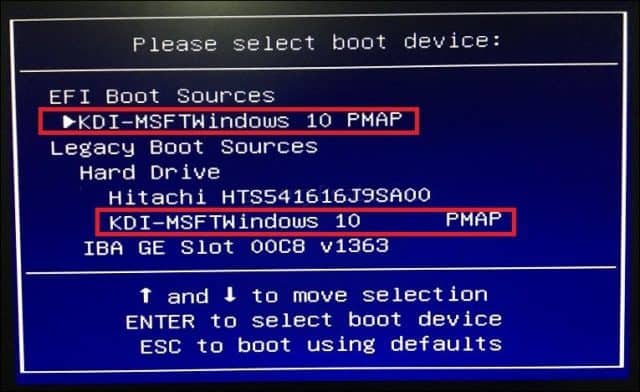
Here is a list of commands for accessing the directly boot menu on popular brands:
| Brand | Command |
| Acer | Esc / F9 / F12 |
| Asrock | F11 |
| Asus | Esc / F8 |
| Compaq | Esc / F9 |
| Dell | F12 |
| Fujitsu | F12 |
| Gigabyte | F12 |
| HP | Esc / F9 |
| Intel | F10 |
| Lenovo | F12 |
| MSI | F11 |
| Packard Bell | F8 |
| Samsung | Esc |
| Sony Vaio | F11 |
| Toshiba | F12 |
Microsoft Surface and Mod Windows ten Devices
The Microsoft Surface uses its own unique interface for booting into the UEFI firmware interface.
First, you need to admission your BIOS / UEFI setup utility on your Surface.
- Make sure your Surface or Surface Pro is fully powered down.
- Printing and concord the volume up button located on the left side of the device.
- Press and hold the power button for 5 seconds located on the summit of the device.
- Release the power button after v seconds but go on to concur downwardly on the volume button until you see BIOS UEFI.
The Surface uses a combination of text-driven interface, bear on, and mouse input to modify boot settings. Navigate down to the option Configure Alternate Organization Kicking Guild using the downwardly arrow key. Hit the Enter key, which volition load a submenu; utilize the upward and down arrow to select the commencement kicking device then hit Enter.
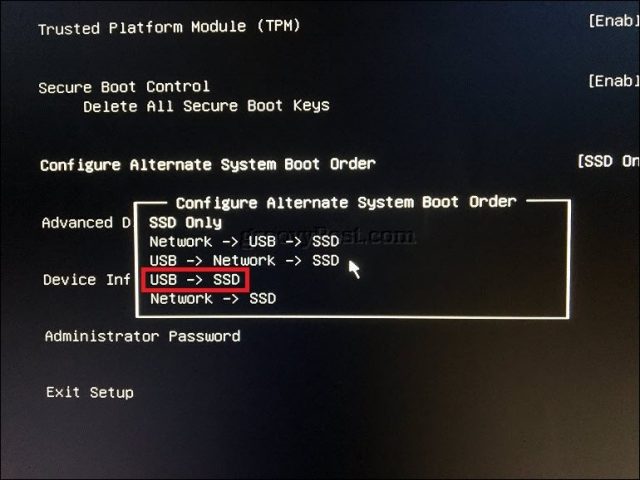
Navigate down to the Exit setup bill of fare, hit Enter, use the left or right arrow keys to select yes and then striking Enter.
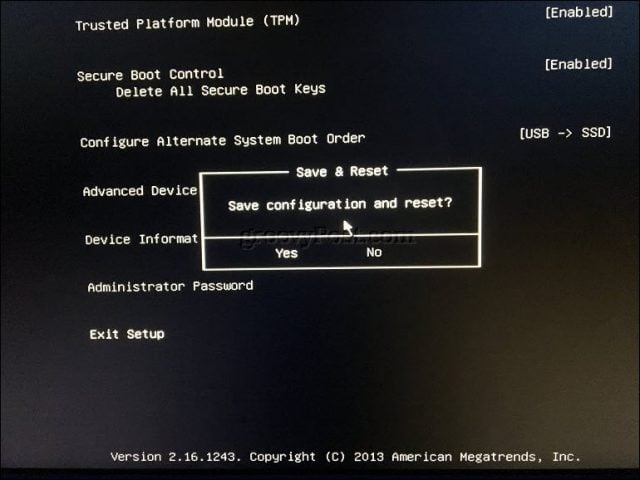
Configuring UEFI on Windows viii or Windows ten Computers
If your computer or device is already running an existing version of Windows 8 or Windows 10, you might be able to initiate booting from removable storage from within the operating system. Click Start > Settings > Update & security > Recovery. And then, under Advanced startup, click Restart at present.
If this option is non available, sign out of Windows 10, so hold down the shift primal, click the Power carte, then click Restart. Continue to hold downwards the shift central then await until the Recovery environment is loaded. The Cull an option bill of fare lets you access and boot from removable media attached to the organisation.
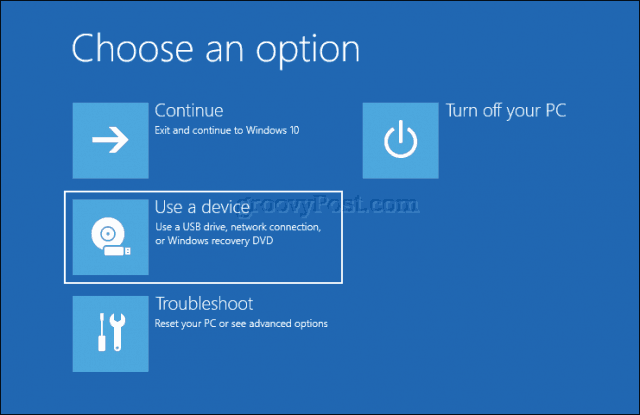
If you need to access advanced boot options, click Troubleshoot, then click the UEFI Firmware Settings to make farther changes.

What Well-nigh Mac?
For the by x years, Apple tree Intel-based Macintosh computers have supported Windows. Most Macs will allow you lot to kick from a CD by pressing and holding C on startup. Booting an operating system other than Bone 10 or macOS from a USB drive is a little more involved. We previously covered preparing your Mac for installing Windows x using the Boot Army camp sorcerer in macOS. After preparing your kick camp sectionalization and install media, booting from it is as elementary as holding down the Option key earlier you hear the startup chinkle.
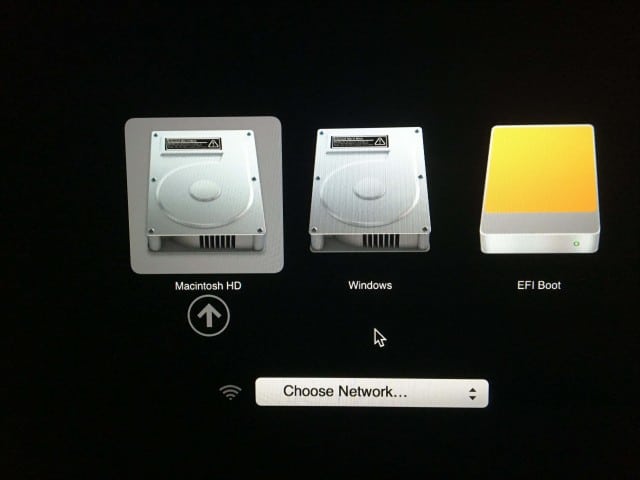
Conclusion
1 of the lessons users will larn from this is that not all computer configurations are akin, even if they are from the same brand. Hopefully, reading through this guide has given y'all enough background cognition most the procedure to help you configure your particular system, or at to the lowest degree enquire the right questions if you run into trouble.
Let us know what you recollect in the comments. If you don't see your specific computer model or brand described in this commodity, let u.s.a. know so we can find it for you.

Source: https://www.groovypost.com/howto/bios-uefi-setup-guide-boot-from-cd-dvd-usb-drive-sd-card/
Posted by: wenzelsymbeentere.blogspot.com

0 Response to "How To Install Windows 10 Bios Settings"
Post a Comment